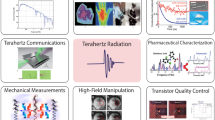Abstract
Based on the ambiguity function, an approach to intra-pulse modulation recognition is presented. This paper defines the frequency energy accumulation function (FEAF) and time-domain extremum function (TEF) to describe the Doppler frequency shift and time delay properties of signals, respectively. This approach can recognize six types of signals by four characteristic parameters. Simulation results show that the probability of successful recognition (PSR) can reach 90% when the signal to noise ratio (SNR) is above −1 dB.
Similar content being viewed by others
References
C.F. Chang, M.R. Bell, Frequency coded waveforms for enhanced delay-Doppler resolution, in Proc. of IEEE Radar Conference, Long Beach, CA, USA, Apr. 2002, pp. 160–167
O.A. Dobre, A. Abdi, Y. Bar-Ness et al., Survey of automatic modulation classification techniques: classical approaches and new trends. IET Commun. 1(2), 137–156 (2007)
W. Gardner, Spectral correlation of modulated signals: Part I-analog modulation. IEEE Trans. Commun. 35(6), 584–594 (1987)
W. Gardner, W. Brown, C.K. Chen, Spectral correlation of modulated signals: Part II-digital modulation. IEEE Trans. Commun. 35(6), 595–601 (1987)
G.S. Gill, J.C. Huang, The ambiguity function of the step frequency radar signal processor, in Proc. of CIE Int. Conf. on Radar, Beijing, China, Oct. 1996, pp. 375–380
G. Lopez-Risueno, J. Grajal, O. Yeste-Ojeda, Atomic decomposition-based radar complex signal interception, in Proc. of IEE on Radar, Sonar, and Navigation, Aug. 2003, pp. 323–331
G. Lopez-Risueno, J. Grajal, A. Sanz-Osorio, Digital channelized receiver based on time-frequency analysis for signal interception. IEEE Trans. Aerosp. Electron. Syst. 41(3), 879–898 (2005)
J. Lunden, V. Koivunen, Automatic radar waveform recognition. IEEE J. Sel. Top. Signal Process. 1(1), 124–136 (2007)
Y. Shen, W.H. Shang, G.S. Liu, Ambiguity function of chaotic phase modulated radar signals, in Proc. of Int. Conf. on Signal Processing, Chicago, IL, USA, Oct. 1998, pp. 1574–1577
A.I. Sinsky, C.P. Wang, Standardization of the definition of the Radar ambiguity function. IEEE Trans. Aerosp. Electron. Syst. AES-10(4), 532–533 (1974)
M.M. Wang, A.K. Chan, C.K. Chui, Linear frequency modulated signal detection using wavelet packet, ambiguity function and Radon transform, in IEEE Int. Symposium on Antennas and Propagation Society, Newport Beach, CA, Jun 1995, pp. 308–311
F.H. Wang, Z.T. Huang, Y.Y. Zhou et al., A new approach for intra-pulse modulation recognition, in Proc. of CIE Int. Conf. on Radar, Shanghai, China, Oct. 2006, pp. 1–5
E.R. Zilberman, P.E. Pace, Autonomous time-frequency morphological feature extraction algorithm for LPI radar modulation classification, in Proc. of the IEEE Int. Conf. on Image Processing, Atlanta, GA, USA, Oct. 2006, pp. 2321–2324
Author information
Authors and Affiliations
Corresponding author
Rights and permissions
About this article
Cite this article
Zeng, D., Xiong, H., Wang, J. et al. An Approach to Intra-Pulse Modulation Recognition Based on the Ambiguity Function. Circuits Syst Signal Process 29, 1103–1122 (2010). https://doi.org/10.1007/s00034-010-9192-6
Received:
Revised:
Published:
Issue Date:
DOI: https://doi.org/10.1007/s00034-010-9192-6




